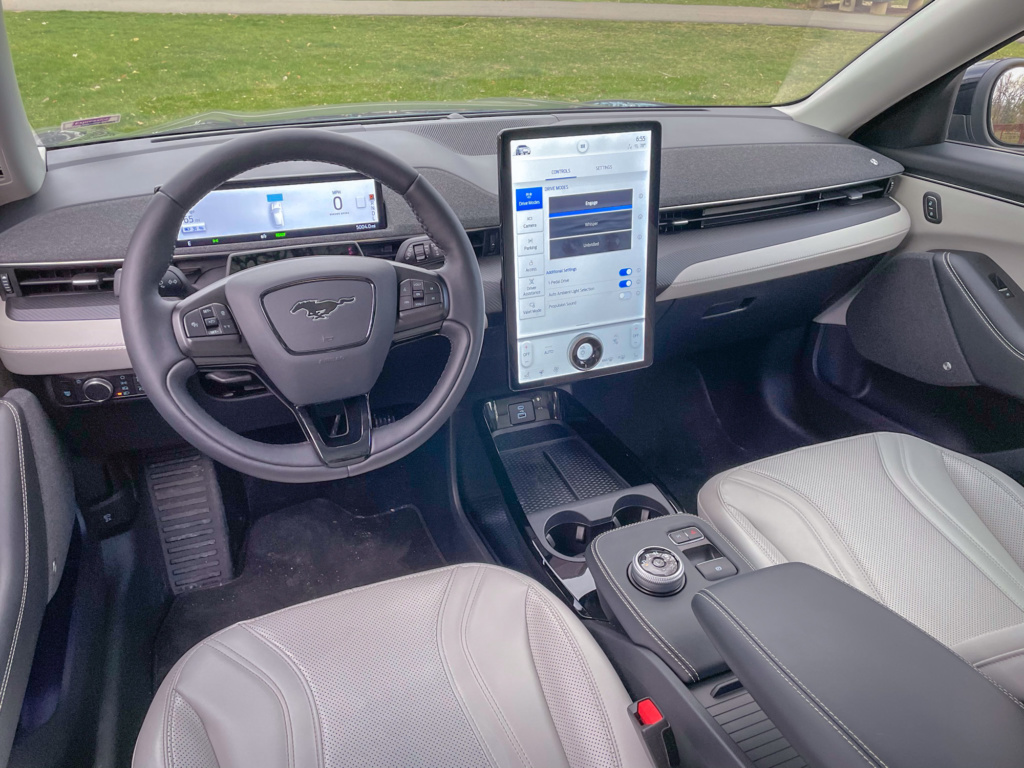Explaining the concept of the Mustang Mach-E to a Mustang enthusiast usually evolves into a Q & A session. Yes, the V8 soundtrack, the sports-car low seating position, and the sleek coupe looks have all been reimagined for this new member of the Mustang brand. Delivering a whoosh, an open family-friendly interior, and a higher-riding body style, the Mach-E is like no other Mustang before it, and for the brand, there’s no turning back.

The fact that this Mustang bears the shape of a crossover is simply a reflection of the current and the foreseeable consumer shift towards the more practical raised-roof design while demand for two-door coupes continues to weaken. For a company that specializes in mass-production, being able to adapt is crucial for the Mustang brand.
The concept of an electric Mustang, on the other hand, invites more conversation. With the enduring legacy of the V8 powertrain and America’s EV infrastructure still in its infancy, it’s easy to question the Mach-E’s timing. But Ford wants to lead the way into the inevitable electrified future and what better way to show its commitment (and the performance advantages of an EV) than with a Mustang.

While the Mach-E is a fundamentally different kind of Mustang, its styling draws strong influence from its past versions with a long hood, a near-horizontal rear fender surface, a fast-back C-pillar (without losing the crossover-practicality), and three vertical light bars that serve as the taillights. It takes an open mind to be convinced of the connection, however, when seen as a fresh interpretation, it works. It has a newness that helps it stand out in the crowded parking lot too – something that’s also important for success in the EV segment.
But just because something is new doesn’t mean it’s necessarily better. The Mach-E takes the flush door handle concept one step further by removing the handle entirely for a smooth and uninterrupted panel surface. Entry requires a focused press of a button above the window line on the B-pillar and then a pull on the plastic flap located just below. If more time is needed to make the switch, a motorized plunger extends from the door to keep it propped open. The process is easy enough to learn (and Ford has how-to videos) but it’s become more complicated without clearly improving the matter.

Exiting also is a new technique. Instead of utilizing an existing design ,the Mach-E features an electronic lever tucked in the door pull pocket that requires a sharp arc of the wrist to operate because it’s positioned so far rearward which actually make the whole process a bit more uncomfortable to perform.
The rest of the interior is easy to appreciate with its open layout but it feels much more EV and crossover than Mustang and sporting. A low and stylish dash panel is highlighted by two prominent display screens, one being a 15.5-inch portrait-style touchscreen that is crisp and easy to use, however, it lacks today’s expected level of customization, and its only physical control, a volume knob, feels disappointingly rough and loose to operate. A slim 10.2-inch display is mounted ahead of the driver and conveys the speed, range, and status of various driving controls but it also lacks the imagination or enthusiasm that one would rightfully expect in a Mustang.

The seats are similar as they fulfill the need for a comfortable seat with easy entry and exit, but their lack of adjustability and bolstering don’t provide the support for anything more adventurous than an on-ramp. But that certainly doesn’t mean hustling the Mach-E isn’t worth doing.
This model’s standard-range battery pack and AWD delivers a confident launch and fast acceleration up to highway speeds and, while it’s not a rocket, the powertrain feels refined and reacts smoothly to sharp pedal inputs – a boon in everyday driving. Its single pedal driving is even expertly tuned and delivers a moderate deceleration rate and a smooth stop. The steering is also smooth in its operation and responds predictably but communicates little of what’s happening at the road surface. The suspension, on the other hand, is stiff and will deliver a big slap to the backside over large bridge gaps or big road dips. Otherwise, the Mach-E feels stable at speed and even was able to demonstrate its newfound skill as a foul-weather handler (thanks to a late season heavy snow) with its exceptional stability control tuning. As good as it is, however, the software can’t hide the significant mass of the battery pack which causes the Mach-E to adopt the slow in and fast out approach to low speed turns. But once they open up, the Mach-E can get the power down and it turns into a playful dance partner that feels very much like a Mustang.

That playful driving will take its toll on the overall driving range. While it’s rated at 210 miles by the EPA, my full-charge ranges were typically far less. So much so that going up into the mountains for a sporting Saturday drive would have caused a bit of anxiety. With a DC Fast Charging station, the Mach-E can be recharged with 38 miles in as little as 10 minutes but more typical charging stations will require significantly more time – up to 11 hours to go from 0%-100%.

Overall, there are multiple aspects that make up the personality of the Mach-E. The exterior speaks convincingly to the Mustang past while the interior whispers EV and crossover practicality. Thankfully, the drivetrain and handling traits resoundingly prove that the Mach-E is much more than just a styling and PR exercise and place it among the most important Mustangs in the brand’s 47-year history.
